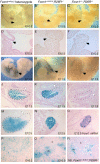Specific expression of lacZ and cre recombinase in fetal thymic epithelial cells by multiplex gene targeting at the Foxn1 locus
- PMID: 17577402
- PMCID: PMC1906761
- DOI: 10.1186/1471-213X-7-69
Specific expression of lacZ and cre recombinase in fetal thymic epithelial cells by multiplex gene targeting at the Foxn1 locus
Abstract
Background: Thymic epithelial cells (TECs) promote thymocyte maturation and are required for the early stages of thymocyte development and for positive selection. However, investigation of the mechanisms by which TECs perform these functions has been inhibited by the lack of genetic tools. Since the Foxn1 gene is expressed in all presumptive TECs from the early stages of thymus organogenesis and broadly in the adult thymus, it is an ideal locus for driving gene expression in differentiating and mature TECs.
Results: We generated two knock-in alleles of Foxn1 by inserting IRES-Cre or IRES-lacZ cassettes into the 3' UTR of the Foxn1 locus. We simultaneously electroporated the two targeting vectors to generate the two independent alleles in the same experiment, demonstrating the feasibility of multiplex gene targeting at this locus. Our analysis shows that the knockin alleles drive expression of Cre or lacZ in all TECs in the fetal thymus. Furthermore, the knockin alleles express Cre or lacZ in a Foxn1-like pattern without disrupting Foxn1 function as determined by phenotype analysis of Foxn1 knockin/Foxn1 null compound heterozygotes.
Conclusion: These data show that multiplex gene targeting into the 3' UTR of the Foxn1 locus is an efficient method to express any gene of interest in TECs from the earliest stage of thymus organogenesis. The resulting alleles will make possible new molecular and genetic studies of TEC differentiation and function. We also discuss evidence indicating that gene targeting into the 3' UTR is a technique that may be broadly applicable for the generation of genetically neutral driver strains.
Figures





References
Publication types
MeSH terms
Substances
Grants and funding
LinkOut - more resources
Full Text Sources
Other Literature Sources
Molecular Biology Databases

